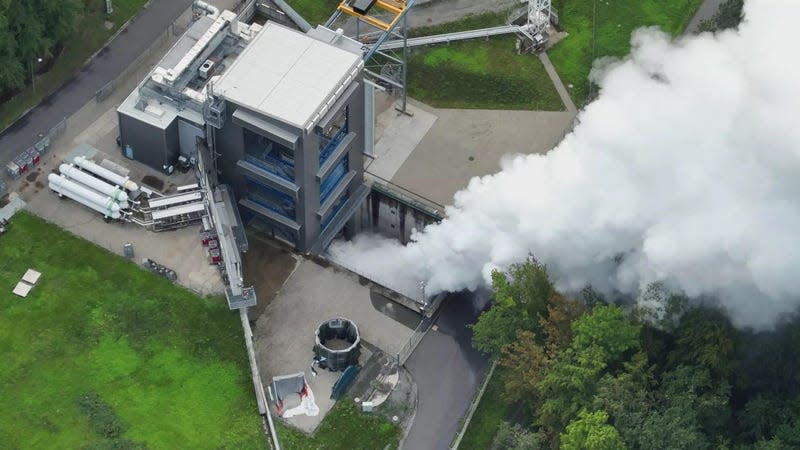Launch Uncertainty Lingers as Ariane 6 Rocket Undergoes Engine Test

The Ariane 6 rocket’s second stage underwent a hot fire test on September 1.
Following numerous delays and technical hiccups, the Ariane 6 rocket is undergoing a series of tests that could finally determine a launch period for the heavy-lift launch vehicle at some point next year.
The European Space Agency (ESA) hopes to set a launch date for the long-delayed Ariane 6 rocket after it completes a series of tests in October. Ariane 6 completed a hot fire test on Friday at the German aerospace agency’s test centre in Lampoldshausen, Germany, ESA announced on Monday. During the test, engineers fired up the rocket’s Vinci upper stage engine, powered by a cryogenic mixture of liquid oxygen and hydrogen, for 11 minutes and went through the sequence of operations that will take place during its first mission. The last of a series of tests is set to take place on October 3, after which ESA hopes to be able to announce a launch date for Ariane 6 that will likely take place in 2024.
Read more
Tesla's Mega 98-Supercharger Location Runs In Part On A Diesel Generator: Report
Airlines Are Racing To Find Fake Parts In Airbus And Boeing Engines
Burning Man Cars Are Ruining Car Washes On Their Way Back From Black Rock City
French company Arianespace is developing the rocket on behalf of ESA, with Ariane 6 serving as a successor to the now-retired Ariane 5. The legendary rocket performed its final flight in July, ending a 27-year run.
Following Ariane 5's retirement, the European space industry has been in dire need of a launch vehicle to provide access to Earth orbit. After cutting ties with Russia following the invasion of Ukraine, Europe was forced to stop relying on the Soyuz rockets for access to space. Aside from Ariane 6, Arianespace’s Vega-C rocket suffered a malfunction in December 2022 that resulted in its destruction and its launches were suspended.
As a result, ESA really needs its Ariane 6 rocket to fly. The 197-foot-tall (60-meter) rocket is capable of lifting 10 metric tons to low Earth orbit, 4.5 metric tons to Sun synchronous orbital (SSO) altitudes reaching 500 miles (800 kilometers), and upwards of 10.5 metric tons to geostationary transfer orbits (GEO).
Even before getting off the launchpad, the rocket already has a busy launch schedule ahead that runs to 2029. Earlier this year, Amazon booked the Ariane 6 rocket for 18 launches to transport the company’s Project Kuiper satellites to low Earth orbit. Ariane 6 is also expected to deliver ESA’s Galileo global navigation satellite system (multiple launches from 2023 to 2025), the Meteosat weather satellites (2024), the Earth Return Orbiter for the Mars sample-return mission (2026), and the upcoming PLATO space telescope (2026), among others.
For more spaceflight in your life, follow us on Twitter and bookmark Gizmodo’s dedicated Spaceflight page.
More from Gizmodo
Joe Alwyn’s Uncharacteristic Photo Dump Has Us Asking: Is He OK?
Watch This RAM TRX Escape A Rained-Out Burning Man With An RV
Man Crossing Atlantic Ocean In Hamster Wheel Arrested After Three-Day Standoff
Sign up for Gizmodo's Newsletter. For the latest news, Facebook, Twitter and Instagram.

